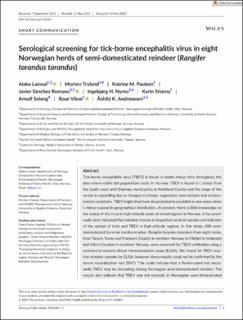| dc.contributor.author | Lamsal, Alaka | |
| dc.contributor.author | Tryland, Morten | |
| dc.contributor.author | Paulsen, Katrine M. | |
| dc.contributor.author | Romano, Javier Sánchez | |
| dc.contributor.author | Nymo, Ingebjørg H. | |
| dc.contributor.author | Stiasny, Karin | |
| dc.contributor.author | Soleng, Arnulf | |
| dc.contributor.author | Vikse, Rose | |
| dc.contributor.author | Andreassen, Åshild Kristine | |
| dc.coverage.spatial | Norway | en_US |
| dc.date.accessioned | 2023-10-11T06:46:02Z | |
| dc.date.available | 2023-10-11T06:46:02Z | |
| dc.date.created | 2023-06-20T13:37:09Z | |
| dc.date.issued | 2023 | |
| dc.identifier.citation | Zoonoses and Public Health. 2023, 1-7. | en_US |
| dc.identifier.issn | 1863-1959 | |
| dc.identifier.uri | https://hdl.handle.net/11250/3095661 | |
| dc.description.abstract | Tick-borne encephalitis virus (TBEV) is found in Ixodes ricinus ticks throughout the area where viable tick populations exist. In Norway, TBEV is found in I. ricinus from the south coast until Brønnøy municipality in Nordland County and the range of the vector is expanding due to changes in climate, vegetation, host animals and environ-mental conditions. TBEV might thus have the potential to establish in new areas when I. ricinus expand its geographical distribution. At present, there is little knowledge on the status of the virus in high-altitude areas of inland regions in Norway. It has previ-ously been indicated that reindeer may be an important sentinel species and indicator of the spread of ticks and TBEV in high-altitude regions. In this study, 408 semi- domesticated Eurasian tundra reindeer (Rangifer tarandus tarandus) from eight herds, from Tana in Troms and Finnmark County in northern Norway to Filefjell in Innlandet and Viken Counties in southern Norway, were screened for TBEV antibodies using a commercial enzyme- linked immunosorbent assay (ELISA). We found 16 TBEV reac-tive reindeer samples by ELISA; however, these results could not be confirmed by the serum neutralization test (SNT). This could indicate that a flavivirusand not neces-sarily TBEV, may be circulating among Norwegian semi-domesticated reindeer. The results also indicate that TBEV was not enzootic in Norwegian semi-domesticated reindeer in 2013–2015. This knowledge is important as an information base for future TBEV and flavivirus surveillance in Norway. | en_US |
| dc.language.iso | eng | en_US |
| dc.rights | Navngivelse-Ikkekommersiell 4.0 Internasjonal | * |
| dc.rights.uri | http://creativecommons.org/licenses/by-nc/4.0/deed.no | * |
| dc.subject | climate change | en_US |
| dc.subject | flavivirus | en_US |
| dc.subject | Ixodes ricinus | en_US |
| dc.subject | sentinels | en_US |
| dc.subject | serology | en_US |
| dc.subject | TBEV | en_US |
| dc.subject | ticks | en_US |
| dc.title | Serological screening for tick-borne encephalitis virus in eight Norwegian herds of semi-domesticated reindeer | en_US |
| dc.type | Peer reviewed | en_US |
| dc.type | Journal article | en_US |
| dc.description.version | publishedVersion | en_US |
| dc.rights.holder | © 2023 The Authors | en_US |
| dc.subject.nsi | VDP::Matematikk og Naturvitenskap: 400::Zoologiske og botaniske fag: 480 | en_US |
| dc.source.pagenumber | 1-7 | en_US |
| dc.source.journal | Zoonoses and Public Health | en_US |
| dc.identifier.doi | 10.1111/zph.13060 | |
| dc.identifier.cristin | 2156210 | |
| dc.relation.project | Framsenteret: 362256 | en_US |
| cristin.ispublished | true | |
| cristin.fulltext | original | |
| cristin.qualitycode | 2 | |

